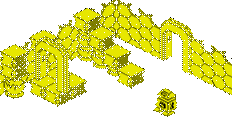NC - Extract from an Article in New Scientist, November 1992
Most people agree that computers should be easier to use, especially portables that are used beyond the reach of the company computer wizard.
Amstrad recently began advertising its new Notepad computer with the slogan, 'If you can't use this in five minutes, you'll get your money back'. I doubt anyone will qualify for the claim, but this does not equate with unqualified recommendation. The Notepad NC100 is an A4-sized portable, which weighs only 1 kilogram and runs on four pen cell batteries, which last up to 40 hours. The Notepad has built-in wordprocessing software and a 48 000 word spellchecker. The use of toy-like coloured keys for the main control functions ensures a quick start for anyone who has never used a personal computer. But so many people are now familiar with personal computer keyboards, that it seems counterproductive to require users to learn nonstandard keystrokes.
In many respects, the Amstrad NC100 is a modern version of the first, and probably best, of all portable computers. The ubiquitous Tandy 100 was launched 10 years ago. For years the 100 was used by journalists all round the world to knock out quick, short stories and send them back to base by electronic mail. Once you wrote a story into the Tandy, it was almost impossible to lose it, even by taking out the batteries for weeks on end. There were a lot of computing options buried inside the chips that many users never even knew about. People just did what they had been taught was necessary for their job.
Like the Tandy 100, the Amstrad NC100 uses an LCD screen, without back lighting, to save battery power. But whereas the Tandy screen showed large characters, which were still visible to tired eyes in poor light, the Amstrad screen shows more lines of smaller text. Ten years ago unlit LCDs seemed tolerable. Today, with virtually all screens backlit, the effect jars. What the Notebook needs is an optional backlight and a control to switch the display between large print and few lines, and smaller print and larger lines. As with the Tandy 100, there is no floppy disc drive. Except where blocked by local telecommunications regulations (as in Britain) the Tandy had a built-in modem for electronic mail. The Notebook has no modem, which seems a missed trick in these days of cheap e-mail and send-only fax modems. Amstrad chairman and managing director Alan Sugar's theory is that people will use the Notebook to write text into internal memory (or plug-in memory cards), and then either connect the unit to a printer or transfer the data to a personal computer.
There is also an odd transition in the Notebook instruction manual. It jumps from a clear description of simple use to a black hole of jargon for buffs. The printing options, for text layout, seem far too exotic for someone who just wants to get words onto paper. The description of data transfer, to and from a personal computer, and by external modem, is hard to follow. I made some transfers work, but only after quite a lot of time and experiment.
My bet is that Alan Sugar had told his designers to produce a cheap and simple modern version of the Tandy 100. The designers found some chips and software that did too much. Sugar oversaw the first part of the manual that tells him what he wanted to know. He then handed the rest of the job to a band of boffins. I suspect I shall now go back to using my Tandy. Anyone without a Tandy, and tired of carrying portable personal computer with flat batteries, should certainly consider the Notepad as a cheap tool. But be sure to try the screen for visibility before buying.









